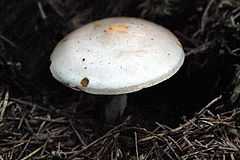Tephrocybe rancida
| Tephrocybe rancida | |
|---|---|
 | |
| Scientific classification | |
| Kingdom: | Fungi |
| Division: | Basidiomycota |
| Class: | Agaricomycetes |
| Order: | Agaricales |
| Family: | Lyophyllaceae |
| Genus: | Tephrocybe |
| Species: | T. rancida |
| Binomial name | |
| Tephrocybe rancida (Fr.) Donk 1962 | |
| Synonyms[1][2] | |
|
Agaricus rancidus Fr. 1821 | |
| Tephrocybe rancida | |
|---|---|
|
| |
| gills on hymenium | |
|
cap is convex or flat | |
| hymenium is free | |
| stipe is bare | |
| spore print is white | |
| ecology is saprotrophic | |
|
edibility: unknown or inedible | |
Tephrocybe rancida is a species of fungus in the family Lyophyllaceae. It was first described by Swedish mycologist Elias Magnus Fries in 1821. T.rancida is commonly called the Rancid Greyling due to its typical coloring and rancid smell and taste.
Description
Cap 1–4 cm in diameter. Convex to flat, umbonate. Grey to brown-grey starting with a whitish bloom. Shiny when wet. Gills Free, crowded, grey. Stem 4-8 cm long by 3–7 mm in diameter, concolorous with cap. Spores white or cream, ellipsoid, 7–8 × 3–4.5 m.
Distribution and habitat
Found growing from the ground, solitary in deciduous woodland. Early autumn to early winter. Rare. North America and Europe.
Edibility
Unknown, inedible due to rancid smell and taste.
External links
| Wikimedia Commons has media related to Tephrocybe rancida. |
References
- ↑ "Tephrocybe rancida (Fr.) Donk 1962". Encyclopedia of Life. Retrieved 17 May 2011.
- ↑ "Tephrocybe rancida (Fr.) Donk 1962". MycoBank. Retrieved 17 May 2011.